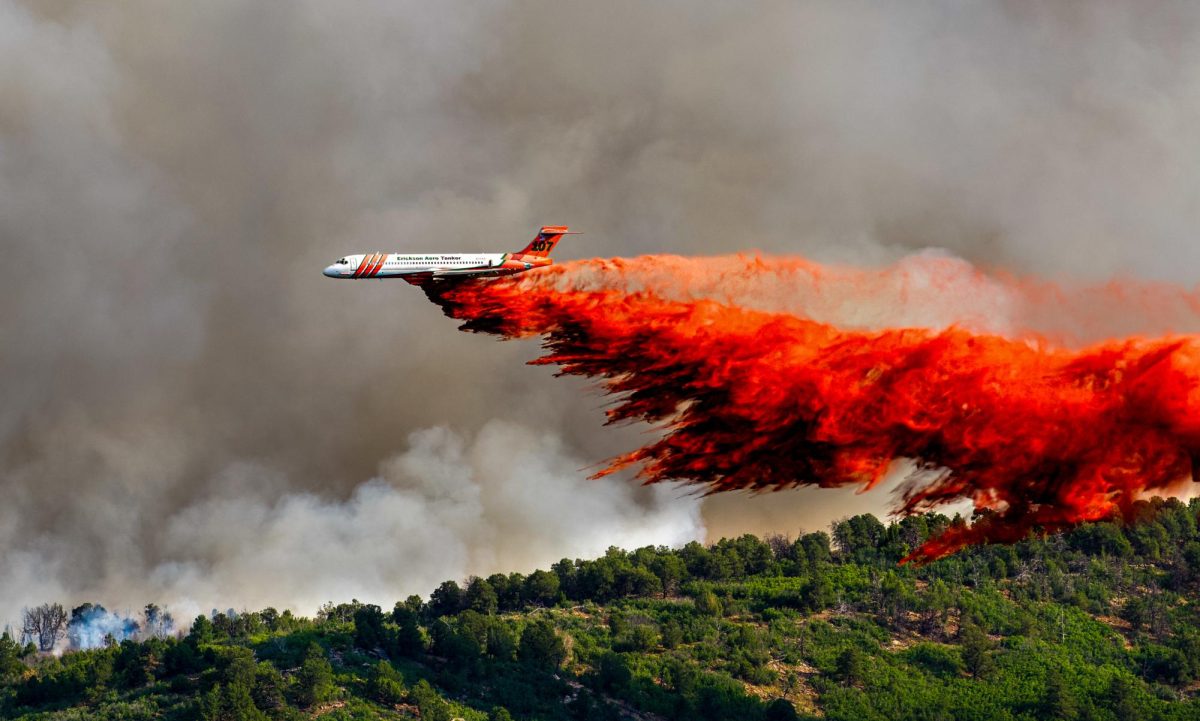
Enrique Quintero
An Erickson Aero Tanker fire bomber disburses a fire retardant over the forest to slow the spread of the Turner Gulch wildfire.
The fourth-largest wildfire in Colorado history continued to scorch the Western Slope this August. The recent fires in the area have now been considered the worst since 2020, having burned over 200,000 acres over the summer, according to Colorado News Line.
Smoke clouded the skies for several weeks in Grand Junction before the fall semester started. Origins of the fire are largely attributed to climate catastrophe. To mitigate its impact, an executive order by Governor Jared Polis declared these fires a “state of disaster,” bolstering the Division of Fire Prevention and Control (DFPC) to eliminate existing hot spots.
Along with verbally supporting the DFPC, the executive order increased the funding of the Wildfire Emergency Response Fund (WERF) to $2.5 million.
Despite this recent resurgence of occurrences, Colorado is historically known for its fire season, which occurs from May to September. The Bureau of Land Management (BLM) also designates Grand Junction as Upper Colorado River District on the fire map, which requires stage one fire restrictions on open fires, smoking in closed spaces and welding with open flames.
Continuous droughts create conditions for plants to become fuel, especially as the dry winter did not supply enough snow pack moisture to prevent fire. Activity ignoring these restrictions provides the necessary spark to ignite the new critically dry fuel, which is typically the source of these fires according to Colorado News Line.
As of August 26, there are three uncontained fires in the area caused by lightning. The Lee Fire near Meeker in Rio Blanco County has burned an estimated 138,844 acres, nearing 90% containment. Stoner Mesa Fire near Cortez destroyed around 10,249 acres and is 42% contained. The Turner Gulch Fire near the Utah border in Mesa County is 96% contained and burned around 31,699 acres.
Colorado State University’s Fact Sheet 6.305, Wildfire Mitigation Series, Landscaping and Planting explains that fire is inherent to Colorado, and human-designed landscapes must prepare for fires as a matter of when, not if. It reads that “most of Colorado’s vegetation has adapted to wildfire and is flammable.”
In relation, the Ute tribe historically used controlled burns to rejuvenate the soil and maintain fire-ecosystem balance, before being systematically forced to stop burning, due to concerns by settlers in the region, as reported by the Colorado Commission of Indian Affairs.
“Continuous fuel is not really a thing in Grand Junction due to the desert climate,” said wildland fire management and environmental science student Patrick Preston. “Fire is a piece of the Colorado ecosystem and, if we focus on fire suppression over management, we will have more devastating fires.”
Fire land management is the key to preventing devastating fires and CMU offers a program to aid in the sustainability-focused initiative. CMU Tech’s Wildland Fire Management Program has been active in the recent fires, with some graduates working in the state in fire control.
Students are sent both to local fires and locations across the United States. Classes focus on nature and fire management, with the goal to preserve life first, and then property. Students outside the program may feel that the goal should be to stop all fires, however, the students in the CMU Tech program report a different perspective for the Colorado fires.
“Sustainability is the nature of wildfires, and fire is usually good for the ecosystem, as it is sometimes better to let it burn brush and prevent a larger fire from building up new fuels,” said EMT-paramedic major Evelyn Rennaker, who works in wildlife management. “We train daily, carrying these 45lb bags, waking up at 6 a.m., and it is not as easy as putting water on the fire to stop it.”
The current fires may continue to grow in intensity as Colorado continues to experience increases in temperature. The University of California Los Angeles and Columbia determined that the current mega-drought is the worst that Colorado has experienced in the last 1,200 years.
To aid the threat, students in the program take classes covering subjects such as environmental science, geology, fire ecology, firefighting and EMT work.
“We want people to understand that fire is not a bad thing, but rather a force of rebirth in the ecosystem, especially with the local agricultural land providing fuel for new fires,” said Instructor of the Wildland Fire Management program Alison Robb. “What we need is for people to adapt to fire season, develop consciousness of our environment, as most are privileged to be uneducated on fire’s role in Mesa County’s ecosystem.”
The Wildland Fire Management program continues to put their student focus on environmental and emergency training, with hopes to preserve life.